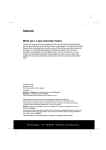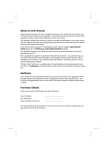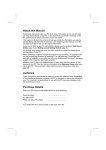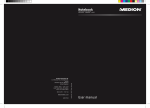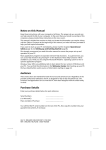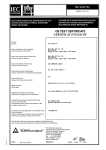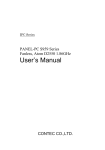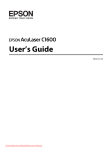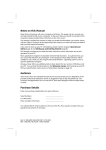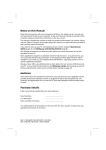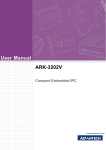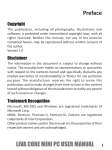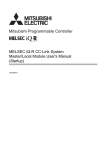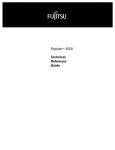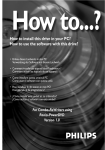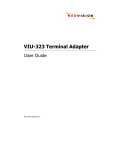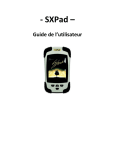Download - Net-s.pl
Transcript
Notes on This Manual Keep these instructions with your computer at all times. The proper set up, use and care can help extend the life of your computer. In the event that you transfer ownership of this computer, please provide these instructions to the new owner. This manual is divided into sections to help you find the information you require. Along with the Table of Contents, an Index has been provided to help you locate information. In addition, many application programs include extensive help functions. As a general rule, you can access help functions by pressing F1 on the keyboard. These help functions are available to you when you use the Microsoft Windows® operating system or the various application programs. This interactive manual is designed to provide additional information about your Notebook as well as useful links accessible via the World Wide Web. Windows Vista offers you an additional aid to learning about the operating system and your PC in the Welcome Center. We listed further useful sources of information starting on page 57. Audience These instructions are intended for both the novice and advanced user. Regardless of the possible professional utilization, this notebook is designed for day-to-day household use. The functions and applications for use with this notebook have been designed with the entire family in mind. Document Your Notebook It is important to document the details of your notebook purchase in the event you need warranty service. The serial number can be found on the bottom of the notebook: Serial Number ...................................... Date of Purchase ...................................... Place of Purchase ...................................... Quality We have selected the components in this computer for their high level of functionality, ease of use, safety and reliability. Through balanced hardware and software design we are able to provide you with an innovative personal computer useful for applications relating to both work and leisure. We are pleased to welcome you as our newest customer. Thank you for choosing our company. Service We are pleased to provide individualized customer service throughout the life of your notebook. Please feel free to contact a customer service representative with any questions relating to this notebook. Copyright© 2007 Medion®. All rights reserved. Microsoft®, MS-DOS®, and Windows are registered trademarks of Microsoft Corporation in the U.S. and other countries. Pentium® is a registered trademark of Intel Corporation. The names of actual companies and products mentioned herein may be the trademarks of their respective owners. Information in this document is subject to change without notice. ii Table of Contents Safety and Maintenance .............................................. 1 Safety Instructions ................................................... 3 Data Security........................................................ 4 Set-Up Location .................................................... 4 Ambient Temperature ............................................ 5 Working in Comfort................................................ 6 Connecting ........................................................... 7 Power Supply .................................................... 7 Cabling ............................................................ 8 Information about the regulatory compliance according to R&TTE................................................ 9 Modem ................................................................ 9 Touch Pad ............................................................ 9 Battery Operation ................................................ 10 Views & first setup .................................................... 11 Included with Your Notebook ................................... 13 Views of the Notebook ............................................ 14 Open Notebook ................................................... 14 Front View.......................................................... 15 Left Side ............................................................ 15 Right Side .......................................................... 15 Rear Side ........................................................... 16 Device Indicators................................................. 17 Getting Started ...................................................... 18 How to start: ...................................................... 18 Step 1............................................................ 18 Step 2............................................................ 20 Step 3............................................................ 20 Short description of the Windows® Desktop ......... 21 Main Components...................................................... 23 Power Supply......................................................... On/Off button ..................................................... Power Adapter .................................................... Battery Operation ................................................ Inserting the Battery........................................ Removing the battery....................................... Charging the Battery........................................ Discharging the battery .................................... Battery Performance ........................................ 25 25 26 27 28 28 29 29 30 iii Power Management ............................................. Sleep Mode ( Ö ).................................... Hibernate Mode ( Ö ) ................................. Display ................................................................. Opening and Closing the Display............................ Screen Resolution................................................ Connecting an External Monitor ............................. Duplicating the Desktop.................................... Extending the Desktop ..................................... Connecting a TV .................................................. Data Entry ............................................................ The Keyboard ..................................................... Notebook-specific key combinations ................... The Touchpad ..................................................... The Hard drive ....................................................... Important Directories ........................................... The Optical Drive.................................................... Loading a Disc .................................................... Emergency Ejection of a blocked Disc ................. Playing Back and Retrieving Data from Discs ........... Regional Playback Information for DVD................... Subjects Concerning the CD/DVD-Rewriter.............. Recordable/Rewriteable Discs ............................ The Sound Card ..................................................... External Audio Ports ............................................ Modem ................................................................. Modem port ........................................................ The Network .......................................................... What is a network? .............................................. Ethernet-Network ............................................ Wireless LAN................................................... The Express Connection .......................................... Installing Express Card......................................... Removing Express Card........................................ Universal Serial Bus (USB) Port ................................ Securing the Notebook ............................................ Startup Password ................................................ Using a safety lock .............................................. iv 31 31 31 32 32 33 34 34 35 36 37 37 37 38 39 40 41 41 43 43 44 45 45 46 47 49 50 51 51 51 52 54 54 54 55 56 56 56 Software ............................................................... 57 Getting to Know Windows Vista ............................. 57 Windows Vista - Quickstartguide ........................ 57 Windows Vista - Help and Support ..................... 57 Windows Vista – Welcome Center ...................... 58 Windows Vista – User Account Control ................ 59 Installation of Software ........................................ 60 Software Uninstallation..................................... 61 Windows Activation.............................................. 62 Product activation on your PC............................ 62 The BIOS Set-up-Program .................................... 63 Running the BIOS Set-up.................................. 63 First Aid .................................................................... 65 FAQ – Frequently Asked Questions............................ Data and System Security ....................................... Data Security...................................................... Maintenance Programs ......................................... Password Reset Disk ............................................ Windows® Update................................................ Windows Update Information for Data Security .... System Recovery ................................................... Correction .......................................................... System Restore powered by Symantec ................... Limits of the Recovery...................................... Performing the Restore..................................... Troubleshooting ..................................................... Localize the Cause ............................................... Check Cables and Connections .......................... Errors And Possible Causes ............................... Additional Support ............................................... Driver Support .................................................... Maintenance .......................................................... Care of the TFT Display ........................................ Transporting the Notebook.................................... Recycling and Disposal ......................................... Batteries and Proper Treatment ......................... Upgrades and Repairs .......................................... Notes for Service Engineers .............................. 67 69 69 69 69 70 71 72 72 73 73 73 74 74 74 75 76 76 77 77 78 79 79 81 81 v Appendix ................................................................... 83 Standards ............................................................. Electromagnetic Compatibility ............................... ISO 13406-2 Class II ........................................... FCC Compliance Statement ................................... Warranty .............................................................. Liability limitations............................................... Copying this manual ............................................ Index ................................................................... vi 85 85 85 88 89 90 90 91 Safety Chapter 1 Subject Page Handling Safety and Maintenance Data Security.............................................. 4 Set-up Location........................................... 4 Connecting ................................................. 6 Information about the regulatory compliance according to R&TTE...................................... 9 Modem ...................................................... 9 Touchpad .................................................. 9 Components Environmental Conditions ............................. 5 Appendix Aid Battery Operation ....................................... 10 2 Safety and Maintenance Safety Safety Instructions Please follow the instructions in this section for the safe operation of your notebook: • Do not allow small children to play unattended with electrical equipment. Children are incapable of judging potential risks properly. Handling • Keep the packing materials, such as foil away from children. The danger of suffocation could arise in the case of misuse. • Do not open the case of the notebook, the battery or the power adaptor. When the case is open there is a danger of severe electric shock. Components • CD-ROM-/CDRW-/DVD-drives are Laser Class 1 devices. These lasers must remain in their sealed casing. DO NOT remove the drive covers, as exposure to the lasers may be harmful. • Do not insert objects through the slots and openings of the notebook. This may lead to electric shock, electrical shortcircuit or fire that will damage your notebook. • Slots and openings in the notebook serve to ventilate it. Do not cover up these openings, because the notebook could overheat otherwise. Aid • The notebook is not intended to be operated in a heavy industry company. Operation under extreme environmental conditions can result in damage to your notebook. • Do not operate the notebook during a thunderstorm, in order to avoid damage through lightning strike. Safety Instructions Appendix • Do not cover the slots and openings of the notebook. Never place objects on top of the notebook that would exert any pressure on the display. There is a danger that even slight pressure may break the TFT display. 3 • There is a risk of injury if the TFT display breaks. Use protective gloves to pack up the broken pieces and contact customer service to arrange for proper disposal. It is important to thoroughly wash your hands after handling a broken TFT display. There is a chance that chemicals may have been released. • Do not forcibly open it. • In order to avoid damage to the display, do not touch it with your fingers or sharp objects. • Never lift the notebook by the TFT Display; doing so could break the hinges. Switch off your PC immediately or do not switch it on at all and contact customer service … • … if the power cord or the connectors attached to it are burnt or damaged. Replace the defective power cord with an original power cord. Under no circumstances may a defective power cord be repaired. • ... if the housing of the PC is damaged or fluids have leaked into it. Have the PC checked by customer service first, because the PC may not be safely operated otherwise and there may be a life-threatening risk of electrocution! Data Security • Every time you update your data make back-up copies on an external storage medium. The supplier does not assume liability for data loss or damage to data storage units, and no claims can be accepted for damages resulting from the loss of data or consequential losses. Set-Up Location • Keep your notebook and all connected peripherals away from moisture, dust, heat and direct sunlight. Failure to do so can lead to notebook malfunction or damage. • It is highly recommended you do not use the notebook outdoors. • Operate the notebook and all peripherals on a stable, balanced and vibration-free surface. 4 Safety and Maintenance Safety • Do not leave the base of your notebook on your lap or any part of your body for a long period of time. The notebook can become very warm while it is turned on or charging and can cause discomfort or injury from heat exposure. Handling • In the first hours of operation, new devices may emit a typical, unavoidable but completely harmless smell, which will decline increasingly in the course of time. We recommend you to ventilate the room regularly, in order to counteract the formation of the smell. During the development of this product, we have made sure that the applicable limits are clearly fallen below. Ambient Temperature Components • The notebook is most reliably operated at an ambient temperature between +41° and +104° F and at a relative humidity between 20% and 80% (without condensation). • When powered off, the notebook can be stored at temperatures between 32° and 140° F. • Unplug the cable during thunderstorms and make especially sure to remove the antenna cables, if present. We recommend the use of a surge protector for additional safety, in order to protect your notebook from being damaged by power peaks or lightning strikes through the power network. Aid • Wait until the notebook has reached ambient (room) temperature before turning it on or connecting it to the power adapter. Drastic variations in temperature and humidity can create condensation within the PC and may cause it to short-circuit. Appendix • For transporting the notebook keep the original packing. Safety Instructions 5 Working in Comfort Sitting in one position for long periods can be uncomfortable. To minimize the potential for physical discomfort or injury, it’s important that you maintain proper posture. • Back – While sitting at your work surface, make sure your back is supported by the chair’s backrest in erect position or angled slightly backwards. • Arms – Your arms should be relaxed and loose, elbows close to your sides, with forearms and hands approximately parallel to the floor. • Wrists – Your wrists should be as straight as possible while using the keyboard, mouse or trackball. They should not be bent sideways, or more than 10 degrees up or down. • Legs – Your thighs should be horizontal or angled slightly downward. Your lower legs should be near a right angle to your thighs. Your feet should rest flat on the floor. If necessary, use a footrest, but double check that you have your seat height adjusted correctly before getting a footrest. • Head – Your head should be upright or tilted slightly forward. Avoid working with your head or trunk twisted. • Overall – Change your position frequently and take regular breaks to avoid fatigue. 6 Safety and Maintenance Safety Connecting Pay attention to the following information, in order to connect your notebook correctly: Power Supply Handling • Do not open the power adapter housing. When the housing is open there is a danger of severe electric shock. It contains no user-serviceable parts. • The electric outlet must be in the vicinity of the notebook and within reach of the power adapter cables. • To disconnect your notebook from the power source, or set the notebook to battery operation, remove the power cord from the notebook’s power socket. Components • Only use the notebook with a power adaptor operating at AC 100-240V~, 50/60 Hz. For details on power consumption, please refer to the rating plate on the rear of your notebook. If you are unsure of the type of power supply available at the point of use, ask your local power company. • Use only the supplied power cord and power adapter. • If using an extension cord, make certain that it meets your local safety requirements. If in doubt, consult an electrician. Aid • To provide additional protection against electric shock, power surges, lightning strikes, or other electrical damage to your notebook, we recommend the use of a surge protector. Appendix • Firstly remove the plug, and then the connector of the notebook, from the power source, if you want to detach the network adapter from the mains power supply. A reverse sequence could damage the network adapter or the notebook. Always hold the connector firmly when removing it. Never pull on the power cord. Safety Instructions 7 Cabling • Arrange cables so no one can walk on or trip over them. • Do not place objects on any of the cables. • To avoid damage to your PC, connect your peripherals (e.g., keyboard, mouse and monitor) whilst your notebook is powered off. Some devices can be connected whilst your notebook is in use. These devices usually have a USB or IEEE 1394 connector. Please follow the appropriate instructions for each device. • Keep the notebook at least one meter (approximately three feet) away from high frequency and magnetic interference sources (e.g., televisions, loudspeaker cabinets, mobile telephones, etc.) in order to avoid malfunctions and/or loss of data. • Please note that only shielded cables shorter than 3 metres (9.84 ft) should be used for the LPT, COM, USB, IEEE 1394, audio, video and network interfaces with this notebook. Please use only doubly screened cables in the case of printer cables. • Do not replace the cables supplied. Only use the cable supplied with the notebook, since that cable will have been tested extensively in our laboratory. • Also only use the connection cables supplied with the devices to connect your peripherals. • Make sure that all connecting cables are connected with the respective peripheral devices, in order to avoid perturbing radiation. Remove any cables not needed. • The connection of devices is limited to equipment that complies with EN60950 “Safety of information technology equipment” or EN60065 “Audio, video and similar electronic apparatus. Safety requirements”. 8 Safety and Maintenance Safety Information about the regulatory compliance according to R&TTE The following remote equipment has been supplied with this notebook: • Wireless LAN • Bluetooth (external USB Bluetooth dongle) Handling The company declares herewith that these devices are in agreement with the fundamental requirements and the other relevant terms of the 1999/5/EG Guideline. Complete declarations of conformity are available under www.medion.com/conformity. Components The modem meets the requirements of TBR21 (01/1998) and EG201120/V1.1.1/01/98 regarding connection with an analogue telephone network. Modem • If your system has a modem, please make sure you connect it to an analogue telephone line only. Connecting to a digital PBX, a digital line designed for broadband services or ISDN, a shared service line or a payphone will damage the modem or the devices to which it is connected. Touch Pad Appendix Aid • Light pressure with the tip of your finger is all that is required to operate the touch pad. Because the touch pad is electrostatic sensitive, objects cannot be used in place of your fingers. Using a pen or other object can damage the touch pad or cause the notebook to malfunction. Safety Instructions 9 Battery Operation To extend the life and power of your battery and guarantee secure operation, the instructions below should be followed: • Never expose the battery to direct sunlight or heat for long periods. • Do not dispose of the battery by fire. • Disregarding these instructions will lead to damage and under some circumstances may even cause the battery to explode. • Do not open the battery housing; it contains no userserviceable parts. • Keep the battery away from electrically conductive materials, chemical substances and cleaning agents. • Only use the originally supplied power adapter to charge the battery. • Ensure (through the display or the signalling sound of the notebook) that the battery is completely discharged before recharging it. • Replace the battery only with the same type or an equivalent type recommended by the manufacturer. • Charge the battery only until the battery charging light goes out. Also, refer to the instructions under “Charging the Battery” on page 29 for instructions on checking the battery level. • Only change the battery when the unit is switched off. • Batteries are classified as special waste and should always be disposed of properly. Contact Customer Service for more details. 10 Safety and Maintenance Safety Chapter 2 Subject Page Handling Views & first setup Included with Your Notebook............................. 13 Front View...................................................... 15 Left Side ........................................................ 15 Right Side ...................................................... 15 Rear Side ....................................................... 16 Device Indicators ............................................ 17 Components Open Notebook ............................................... 14 Appendix Aid Getting started ............................................... 18 12 Views & first setup Safety Included with Your Notebook Please check that the contents are complete and notify us within 14 days of purchase if any of the following components are missing: Handling • Notebook • Battery • Power Pack with Connection (FSP065-AAC) • Support CD • OEM Version of Operating System Appendix Aid Components • Documentation Included with Your Notebook 13 Views of the Notebook Open Notebook 8 1 2 3 3 7 6 5 4 14 1 - Power Saving Quick Button 2 - Power ON/OFF .......................................... (Ö p. 25) 3 - Stereo speaker 4 - Device indicators 5 - Touchpad ................................................. (Ö p. 37) 6 - Microphone ............................................... (Ö p. 46) ..................................... (Ö p. 17) 7 - Keyboard ................................................ (Ö p. 37) 8 - TFT display ............................................... (Ö p. 32) Views & first setup 9 Safety Front View 9 10 11 12 - Display catch ........................................... (Ö p. 32) Handling 10 - Microphone connector ................................ (Ö p. 46) 11 - Audio In connector ..................................... (Ö p. 47) 12 - Audio Out / S/PDIF connector ..................... (Ö p. 47) 13 14 15 13 - External monitor port VGA Components Left Side 16 ........................ (Ö p. 34) 14 - Modem port (RJ-11) ................................... (Ö p. 49) 15 - LAN port (RJ-45) ........................................ (Ö p. 49) 16 - Express port ............................................. (Ö p. 54) Aid Right Side 17 - Optical Drive 18 Appendix 17 ........................................... (Ö p. 41) 18 - USB Port .................................................. (Ö p. 55) Views of the Notebook 15 Rear Side 19 20 18 21 19 - Power socket ............................................ (Ö p. 26) 20 - TV out port (S-video) ................................. (Ö p. 36) 18 - USB Port .................................................. (Ö p. 55) 21 - Kensington® lock........................................ (Ö p. 56) 16 Views & first setup Safety Device Indicators LED's indicate the power and operating system states of the notebook. The meaning of each LED is: Operating indicator On System is in full operation. Blinking System is in Standby mode. Handling It is explained in the following how this LED behaves in different situations: Battery indicator On Battery pack is being recharged: fast-charge or pre-charge. Off Battery pack is not under recharge. Blinking Battery power is low. Components It is explained in the following how this LED behaves in different situations: Access indicator Aid This LED lights or flashes when the Notebook is accessing the hard disk or the optical drive. Num Lock This LED lights when NUM-Lock has been activated. Capital Lock Appendix This LED lights when CAPS-Lock has been activated. This sets the keyboard to capital letters. Wireless LAN indicator This LED would be lit when the wireless LAN function is activated. Views of the Notebook 17 Getting Started Before you get started using your notebook, first take a few moments to read the important section on Safety. This notebook comes with software fully pre-installed. You do not have to install any of the CDs supplied. How to start: Step 1 • Before starting the notebook please insert the battery. Lock the battery under all circumstances, in order to avoid it falling out unintentionally. • Connect the supplied power adapter to the notebook at the notebook power socket (21). Connect the power adapter via a power cable to a free AC power outlet. • Open the display by pushing the latch-trip (9) to the right with your thumb and then open the display up to the required position with your thumbs and forefingers. 18 Views & first setup Handling Safety • Switch the notebook on by operating the On/Off switch (2). The notebook will start and then run through various phases. Note Components Make sure there is no bootable CD (e.g., the Recovery CD) in the CD-ROM drive. Such disks will prevent the operating system from loading off the hard drive. Appendix Aid The operating system is loaded from the hard disk. During the initial set-up, the loading process takes slightly longer than normal to register the operating system and the individual components completely. Your operating system is finished loading when a welcome screen is shown on your display. Getting Started 19 Step 2 The greeting procedure will guide you through a series of dialogue boxes. The information in each dialogue box will explain the steps that need to be taken. Should you have any questions just click on . • License Agreement The greeting procedure also displays the license agreement. Please read this carefully. It contains important legal information on the use of your software. In order to see the full text, use the mouse and the scroll bar on the right side of the screen to move downwards until you have reached the end of the document. You accept the agreement by clicking on the “I accept the agreement” option field. Only by doing so will you be entitled to use the product under lawful terms and conditions. Step 3 After the login procedure the Windows® desktop appears on your screen. You will find a brief overview on the following pages. After the login procedure the Windows® desktop appears on your screen. This can be adjusted so that the screen of your computer looks different. However, basic operation is guaranteed. 20 Views & first setup Safety Short description of the Windows® Desktop After the login procedure the Windows® Vista desktop appears on your screen. (Your desktop might not look exactly like the one shown here.) Handling s Components t u v n o p q r 1. Start Button Aid Clicking the Start button brings up a menu where you can access help, software programs, files, and settings. 2. All Programs All of the software programs installed on your notebook are ordinarily listed here. Click All Programs to reveal an extensive menu. 3. Program Bar Getting Started Appendix The most commonly used software programs are listed here. 21 4. Turn Off Computer Click on this interface with the left mouse button and select the Shut Down option, in order to switch the Notebook off. 5. Task Bar Here you receive information and status reports about Windows® Vista and which programs are running. 6. Desktop Icons Desktop icons link to their respective programs. To start a program, double-click its desktop icon. 7. Logged in User This tells you which user is logged in to your notebook. 8. Control Panel You can use the icons in Control Panel to change the appearance and functionality of Windows® Vista. These icons represent options for configuring your notebook. 9. Windows® Vista Help Here you can find information on using your notebook, networking, backup, and many other tasks. 22 Views & first setup Safety Chapter 3 Subject Page Handling Main Components Power Supply .............................................. 26 Data Entry .................................................. 36 The Hard Drive ........................................... 39 The Optical Drive ........................................ 41 The Sound Card Modem ......................................... 44 ..................................................... 49 The Network .............................................. 51 Components Display ...................................................... 32 The Express Connection ................................ 54 The Universal Serial Bus (USB) Port .............. 55 Appendix Software ................................................... 57 Aid Securing the Notebook ................................. 56 24 Main Components Safety Power Supply On/Off button The On/Off button (2) is used to power up/down the notebook. Handling The notebook will always be switched off, if the main switch is pressed for more than 4 seconds. Warning! Appendix Aid Components Do not switch off your notebook while the hard disk or the optical drive is running and the corresponding media activity LEDs are lit. Otherwise data may be lost. To protect the hard disk you should always wait for 20 seconds after powering down the notebook before powering it up again. Power Supply 25 Power Adapter Your notebook is supplied with a universal AC power adapter, which automatically adjusts to the available power source. The following levels are supported: AC 100-240V~/ 50-60 Hz. Please follow the power supply safety instructions found on page 7. The power adapter is connected via a power cord to an AC outlet. The DC power lead from the power adapter is connected to the rear side of the notebook (21). The power adapter supplies the notebook with electricity and also charges the battery. The battery is also being charged when you are working on your notebook with the power adapter. The power adapter is still live if the notebook is not connected with it. You should therefore unplug the power adapter from the outlet if it is not connected to the notebook. Warning! Use only the power adapter and power cord supplied with your notebook. 26 Main Components Safety Battery Operation Note Handling Please charge and discharge the new battery completely two to three times in succession, so that it will achieve its full performance! Batteries store electrical energy in their cells and then deliver it when needed. The useful life and performance of your battery depend on careful handling. Components The battery should be completely discharged before a charging process and completely charged again, in order to optimize its useful life and its performance. Appendix Aid You must also pay attention to the Safety Notes from page 8. Power Supply 27 Inserting the Battery Insert the battery pack. Lock the battery under all circumstances, in order to avoid it falling out unintentionally. Removing the battery Open the lock first, in order to remove the battery pack. Then push the battery ejection button and remove the battery from the battery compartment at the same time. Warning! Do not remove the battery while the notebook is running on battery power. You increase the possibility of losing data. Warning! Pay attention that the contacts to the battery and the notebook are not dirty or damaged when storing the battery and using the notebook. This could lead to malfunctions. 28 Main Components Safety Charging the Battery The battery is charged via the power adapter. If the power adapter is connected, it charges the battery automatically, whether the notebook is turned on or not. When the notebook is switched off, full charging takes a few hours. If the notebook is switched on, the charging process takes a significantly longer time. Handling The charging process is regulated by special battery management, through which an increased charging period arises when the device is switched on, so that the complete performance of the notebook is available, even when the battery is being charged. Note Components The charging process will be interrupted if the temperature or the voltage of the battery is too high. Discharging the battery Operate the notebook by means of the battery until it switches off independently because of the low battery charge. Note Appendix Aid Think about saving your open files in good time, to avoid a possible loss of data. Power Supply 29 Battery Performance The particular operating duration will vary according to the setting of the energy saving functions. You can adjust these to your requirements under Energy Options in System Control. Apart from this, your notebook will require a higher power demand when carrying out certain tasks, such as playing back a DVD. Checking the Battery Level In order to check the current level of the battery, move the cursor over the power symbol in the taskbar. The symbol of a battery is displayed during battery operation. You will receive additional information about settings if you double click on this symbol. Note If you ignore the warning signal when the battery level is low, your notebook goes into suspend mode. Warning! Never remove the battery while the notebook is switched on or if the notebook has not yet gone into suspend mode, as this may lead to loss of data. 30 Main Components Safety Power Management Your notebook offers automatic and modifiable power saving functions that you can use to maximize battery life and reduce overall operating costs. The power saving modes are known as sleep mode and hibernate mode. Sleep Mode ( Ö ) Ö Components Hibernate Mode ( Handling When in sleep mode, the contents of the RAM of your notebook are preserved while practically all other components of your notebook are shut down, reducing your power consumption to a minimum. By pressing any key on the keypad, you can bring your notebook back to the fully operational state. You will restart at precisely the line in which you were working prior to the interruption. The computer takes less time to go into and come out of sleep mode, but uses more power than hibernate mode. ) Appendix Aid The hibernate mode is an alternative to a complete shutdown of the notebook. In this mode all data from RAM (system and graphic data) are copied to the hard disk as a file. As soon as the data has been safely saved, the notebook powers down. When the notebook is switched on again, this file is written back to RAM by the BIOS. In a few moments the notebook is in the exact state as when it was last used. If while working on a document the notebook is closed (assuming the correct ACPI setting), the notebook saves the data in RAM for you automatically. You will restart at precisely the line in which you were working prior to the interruption. The computer uses no power while it is in hibernate mode, but it takes a little longer for the computer to go into and come out of hibernation compared to sleep. Power Supply 31 Display Unlike a normal monitor, the TFT display does not produce either radiation or flicker. Opening and Closing the Display The display catches (9) keep the display closed when the Notebook is not in use. 1. To open, use your thumbs to press the bar to the right, then lift the display with your thumbs and index finger and position it as desired. Warning! Do not try to forcibly open the display. The opening and closing of the display can be assigned various functions via the Power management feature. 32 Main Components Safety Screen Resolution The integral screen has a native resolution of 1280 x 800 pixels. If you change to a presentation with different characteristics in the Windows “Personalization” Help Program, the display will not appear on the whole area of the screen, among other effects. Handling Using a higher resolution can lead to distortion of the display, especially with text. Using a lower resolution may cause the display to use only a portion of the screen area. Appendix Aid Components You will adjust the presentation to the mode supported with the Windows “Personalization” Help Program. Display 33 Connecting an External Monitor The notebook has a VGA port (13) for connecting an external monitor. 1. Shut down your notebook. 2. Connect the video signal cable of the external monitor to the VGA port (13) of the notebook. 3. Connect the external monitor to the electrical socket, power it up and start your notebook. 4. Start your notebook. The external screen will be determined after the operating system has been loaded. The following Window will appear and various possible presentations will be offered to you: Duplicating the Desktop This mode duplicates the display of the Notebook on the external monitor. You will switch between the following combinations with the help of the Fn + F5 key combination: • Only Notebook (1 x Fn + F5) • Only external monitor (2 x Fn + F5) • Notebook + external monitor (3 x Fn + F5) 34 Main Components Safety Note Handling The external monitor should support the same screen resolution as your notebook (1280x800), because it is possible to carry out the Cloning Mode otherwise. You will have to adjust the resolution of the notebook to the external monitor under Display Settings, in order to be able to carry out the Fn + F5 command, if your external device does not support the respective resolution. Extending the Desktop An empty Desktop will be displayed on the second [external] monitor in this mode. Windows from the first screen cane shifted to the second one and vice versa. Components This option does not support the key combination Fn + F5. Appendix Aid The screen resolution and the colour quality of the individual display devices can be set under “Control Panel Ö Personalize Ö Display Settings”. Display 35 Connecting a TV The Notebook has a port (20) for connecting a TV. To connect and configure the Notebook for a TV: This option does not support the key combination <Fn> + <F5>. 1. Shut down your notebook. 2. Connect the signal cable of the TV to the TV out port (20) of the Notebook. 3. First turn on your TV, then turn on your notebook. 4. Switch on your notebook and boot it properly. Note If the option Extend the desktop onto this monitor in the program Personalization Ö Display Properties is activated, then it must be deactivated first in order to change the display to the TV set. 36 Main Components Safety Data Entry The Keyboard Handling By dual assignment of certain keys you have the same range of functions available to you as with a normal Windows keyboard. Some functions are input using the Fn key, which is normal on notebook computers. Notebook-specific key combinations Description Wireless LAN Switch (Optional) Components Press this key combination (Fn+F1) to power on and power off the Wireless LAN module. Volume Decreasing Press this key combination (Fn+F3) to decrease volume. Volume Increasing Press this key combination (Fn+F4) to increase volume. Display Switch Aid Press this key combination (Fn+F5) to switch between LCD only, CRT only, and LCD/CRT simultaneously. Brightness Decreasing Press this key combination (Fn+F6) to decrease brightness of LCD display. Brightness Increasing Press this key combination (Fn+F7) to increase brightness of LCD display. Appendix Combination Mute Switch Press this key combination (Fn+F10) to switch off and to switch on the sound. Data Entry 37 Backlight Switch Switches the backlight off to save power. Pressing any key switches the backlight on again. Standby Switch Power saving functions. This key combination is set to Hibernate by default. To adjust this key to your own needs go to Personalization Ö Screensaver in Power Options. The Touchpad The mouse pointer (cursor) follows the direction pre-determined on the touchpad by the movement of your finger in the normal mode. Warning! Do not use a ball-point pen or other object on the touch pad, as this could damage or cause a malfunction of your touch pad. Below the touch pad are the left and right mouse buttons which can be used as on a normal mouse. You can also perform a direct click or double click using the touch pad by tapping the surface briefly once or twice. In the Windows Control Panel you will find a number of useful settings that will make using the touch pad easier. 38 Main Components Safety The Hard drive Components Handling The hard drive is the main storage medium combining large storage capacity and rapid data access. You have acquired an OEM version of the Microsoft Windows® operation system, which will support all the performance features of the notebook completely, with your notebook. We have already configured the hard drive of your notebook so that you will usually be able to work with it optimally, without having to install any software yourself. The Windows® operating system cannot use the full capacity of the hard drive, which means that there will be a difference between the capacity that the BIOS displays and what the operating system displays. The hard drive contains the operating system of the computer, other application programs and backup files. These programs and files are pre-installed on your notebook, so you may note that some of the space on your hard drive is already taken. Whenever the computer is accessing the hard disk, the corresponding LED illuminates (see page 17.) Warning! Never switch off the computer while the busy indicator is lit since this may result in loss of data. Aid If you are looking for a file on the hard drive and you know the name, go to Search on the Start menu to find the file. Following is some general information on where you might find some common files. Usually your hard drive is divided into several partitions, as shown below. The partitions of your hard drive may vary from what is shown here. BOOT C: Windows Software programs RECOVER D: Appendix Your documents Drivers for internal PC components Installation files for software that came with your PC Restore software The Hard drive 39 Important Directories The most important directories preinstalled on your notebook are shown below. Warning! Do not delete or modify these directories or their contents since data could be lost or the functionality of the system could be at risk. Also pay attention to this: You will no longer be able to carry out the recreation of the supply status by means of the Support, if you have converted the Recovery Partition into a NTFS file system. C:\ This is the main hard disk drive partition for your notebook. It is where your program files, settings, and documents are stored, as well as files necessary for running Windows. C:\ Program Files Includes files belonging to software programs. C:\Windows The main directory for Windows. C:\ Documents and Settings Includes the settings and documents for all users. D:\ Driver Drivers for internal notebook components. D:\Tools Includes installation files for software that came with your notebook. D:\Recover Includes the files needed to perform a system restore. 40 Main Components Safety The Optical Drive Loading a Disc Unlike optical drives of desktop PCs optical drives of notebooks retain disks with the help of a locking mechanism. Handling When inserting the disk you should take care to push the disk right onto the locking mechanism so that it can lock in position. Note Components Do not place protective foils or other stickers on your CD’s. To avoid damage to your drive, do not use deformed of damaged CD’s. Warning! Aid Do not use scratched or dirty disks, discs with pieces broken off or disks of poor quality. Because of the high speeds in the drive the disks might break and damage your data as well as your drive. Examine the disks before you enter them. If damage or dirt is visible, you should not use them. Damage caused by faulty media is excluded from warranty and their repair must be charged. Warning! Appendix The CD can be damaged when the drive drawer is pushed in, if it has not been positioned on the support correctly. The Optical Drive 41 1. Press the eject button at the optical drive to open the tray. 2. Pull the tray out completely with care. 3. Remove the disk from its case, without touching the unprinted side if possible. 4. Place the disc on the tray so that it lays flat with the label facing upward and gently push the tray in to close it. The disk will now lie flat on the tray and will engage onto the disk holder audibly. 5. Test that the disk is able to turn freely and then push the tray back into the optical drive carefully. The ‘E’ drive letter will have been allocated to your optical drive in the delivery status. You will have easy access to your files on your disks with Windows Explorer (Computer). Start the Computer Help Program by means of the Desktop link or by pressing the Windows key á and the ‘E’ key at the same time. Open Windows Explorer by means of Start Ö All Programs Ö Accessories. The pre-installed media reproduction will be used automatically during access to DVD videos (or audio and video files on normal data CDs). 6. Press the ejection button on the optical drive, if you want to remove a disk. Warning! While the notebook is accessing the optical drive the media activity indicator is lit. Do not try to remove the CD from the drive while this LED is lit. 42 Main Components Safety Emergency Ejection of a blocked Disc If the tray fails to open automatically, then the tray can be opened manually provided there is an opening for emergency ejection. 1. Shut down Windows and switch off your notebook. Components Handling 2. Insert a long thin object (like a straightened paper clip) into the emergency ejection opening until you feel resistance. 3. Press lightly and the tray will open. 4. Remove the disc and restart the notebook. Playing Back and Retrieving Data from Discs Aid Your notebook is able to playback and to retrieve Audio CDs, DVD Movies and Data discs. After loading the disc your operating system will open a selection window with different options for playback. Normally there are various programs at your disposal. The Optical Drive Appendix If your operating system doesn’t open the selection window you still have the possibility of the access via the “Explorer” or “Computer”. 43 Regional Playback Information for DVD The playback of DVD movies includes the decoding of MPEG2 videos, digital AC3 audio data and the deciphering of CSS protected contents. CSS (sometimes called copy guard) is the name of a data protection program incorporated by the movie industry as an action against illegal copies. Among the numerous regulations for CSS licensees the most important ones are the country specific playback restrictions. In order to facilitate the geographically restricted release of movies, DVD titles are released for certain regions. Copyright laws require the restriction of each DVD movie to a certain region (usually the region, in which it is sold). DVD movie versions can be published in several regions but the CSS regulations require that each CSS decipherable system may only be used in one region. Note The decoding software included with your PC may be changed for regional DVD decoding up to five times, after which the drive will only play DVD movies for the region setting last entered. Changing the region code after that will require factory resetting which is not covered by warranty. If resetting is desired, shipping and resetting costs will be billed to the user. 44 Main Components Safety Subjects Concerning the CD/DVDRewriter This Section only relates to devices that have been supplied with a CD-RW, a combination drive or a DVD-RW drive. First of all, you receive information on the so-called blank discs. Handling Recordable/Rewriteable Discs Normal Discs are pressed from a digital, glass master and then sealed. In the case of blank disc, the information is burnt onto the disc with the laser of the Rewriter. Therefore these discs are more sensitive than normal CDs. Please avoid the following when using recordable/rewriteable discs - especially blanks - that have never before been used: Components • radiation by direct sunlight (UVA/UVB) • scratches and damage to the disk surface Appendix Aid • extreme temperatures The Optical Drive 45 The Sound Card Your notebook has an integrated stereo sound card (on-board) with 16-bit and 3D spatial sound effects (3D). The sound card is compatible with the industry standard Sound Blaster and Microsoft Sound System Version 2.0. This guarantees optimal support for all popular programs and games. If you wish to alter the base volume, click on the loudspeaker symbol in the task bar. Click on Mixer, in order to open the volume mixer. By using the volume control you still have the possibility to regulate the volume. 46 Main Components Safety External Audio Ports Your notebook has a loudspeaker, so you can always playback sounds without additional equipment. The connection of a Hi-Fi system increases the sound quality significantly. The use of the external connections gives you a good opportunity to connect your notebook to external devices. Handling Caution! The use of earphones with a high volume can lead to lasting damage to your hearing. Set the volume to the lowest level before reproducing any sound. Start the sound reproduction and increase the volume to the level that is comfortable for you. Appendix Aid Components It can cause damage to the hearing ability of the listener if a device is operated through earphones with an increased volume for a long period. The Sound Card 47 • Microphone In (10) For recording via an external microphone. For sound reproduction via an external surround system for external center / subwoofer. • Audio Out / Headphones (11) For reception through an external source of sound. • Digital Audio Out (S/P-DIF optical) (12) For sound reproduction via external stereo equipment such as loudspeakers (active) or headphones. For sound reproduction with a surround system for speakers back. For sound reproduction with an external surround decoder via an optical cable (available separately at a specialist shop). By using the external connections you have the possibility to connect your notebook with a 5.1 surround system. 48 Main Components Safety Modem Handling The built-in modem is able to receive data according to the ITU standard for V.90 transmissions with up 56 Kbit/s. Since the power output of modems is restricted due to the regulations of some telecommunication providers, the possible maximum download speed can be restricted. The actual speed may be dependent on the online conditions and other factors. Data sent from the user to the server are transmitted with 31.2 Kbit/s. Prerequisite for this high speed reception is an analogue telephone line compatible with the V.90 standard and a corresponding compatible Internet provider or company-owned host computer. Components The modem is fitted with an RJ-11 interface, into which a standard telephone lead can be plugged. Warning! Appendix Aid Use only with an analogue telephone line. The modem cannot withstand the voltage levels of digital telephone systems such PBX or lines such as ISDN or Broadband services (see safety instructions on page 9). Modem 49 Modem port 1. Insert one end of the RJ11-connection (telephone plug connector) into the modem/network interface (14) and the other into an analogue telephone socket that is easily accessible. Note Do not place the notebook in Hibernate (or Sleep) mode if you are connected to your Internet provider, since this will cause the modem connection to be lost. 50 Main Components Safety The Network What is a network? Handling A network means connecting your notebook to one or several other computers. Users can transfer data between computers and share resources such as printers, modems and hard disk drives. Here are some practical examples: • You can exchange E-mail and manage appointments in an office. • Users can share a printer in a network and save their data on a central server. Components • Users can share one modem among computers for Internet access. • Two or more computers can be connected to play network games or share data. Ethernet-Network Your PC has a Ethernet Network connection. You can use this to connect to a network. Appendix Aid 1. Connect one end to the RJ45 connection (Western plug) at the network interface of your notebook (15) and the other to another PC or a hub/switch. The Windows Help and Support Centre offer extensive information about networking your PC. The Network 51 Wireless LAN Wireless LAN is an optional feature. This function allows you to create a wireless network link with an access point or directly with another wireless-enabled PC. Please read the necessary prerequisites before activating this feature. 1. Using the key combination Fn+F1 you can enable or disable the wireless LAN function. The corresponding LED will light. You will then have the possibility of creating a network connection, if the following requirements have been fulfilled, after the wireless LAN function has been activated. Warning! Make sure the Wireless LAN option is switched OFF in any environment where it might interfere with critical and sensitive devices, e.g., on aircraft, in hospitals and other medical centres, etc. Conditions An access point is a wireless transmitter that communicates with your notebook and controls access to the network connection (e.g., a home network or a broadband connection such as DSL). Wireless access points are often found in offices, airports, universities or Internet cafés. They offer access to networks or to the Internet. Access authorizations are normally needed. A fee may be required to use a public access point. To set up a wireless network to share Internet access, files, and printers at home, you will need an access point, a router, and a broadband (DSL or cable) modem. Some access points can also serve as a router and/or a broadband modem. Check with your retailer or Internet Service Provider to find the best solution for your needs. A link to another computer with wireless LAN functionality can also be created without an access point. This will allow you to share files, but you will need an access point and a router to share an Internet connection. 52 Main Components Safety The wireless network link works according to standard IEEE 802.11g which is also compatible with the IEEE 802.11b standard. The standard 802.11a is supported. If encrypted transmission is used, this must operate according to the same principle on all devices. Encryption is a method of protecting the network from unauthorized access. The transmission speed (max. 54 Mbp/s) can vary according to the distance and loading of the partner. Handling Troubleshooting within the Network Why does an error message appear when I click on the network environment? The computer name must be unique on the network and may not be the same as the task group. Components It appears that the network boards are unable to communicate. What might be the problem? Maybe one of the used network boards works with a different speed (e. g. 10 instead 100 Mbit) and your network computer is unable to recognize this. If necessary, set the network driver to the compatible speed. If two PCs should be linked you require a crosslink cable, otherwise use a patch cable. In addition, check the protocols and the configuration. Aid The data transmission is incorrect or very slow. What might be the problem? Appendix Maybe you have the wrong cable (UTP / CAT3 or lower) or the problem is the proximity of a power cord or another source of interference. The Network 53 The Express Connection Your notebook supports the Express standard. Installing Express Card Note Please always read the instructions that come with your Express card before installation. Removing Express Card Please take note of the following before removing the Express card: • Terminate the program which you used with the card. • Left-click on the icon Safely Remove Hardware taskbar, select the card and click on Stop. in the In order to remove the card, first push it into the contact to unlock it. Pull the card from the bay and store it securely. 54 Main Components Safety Universal Serial Bus (USB) Port The Universal Serial Bus (USB 1.1 and USB 2.0) (18) is a standard for the connection of input devices, scanners and additional peripherals. These devices can be connected at the USB port by means of a single cable. Components Handling Your notebook has 4 USB 2.0 connection sockets (USB 1.1compatible). Devices connected directly to the USB bus should not draw more than 500 mA. Should the devices need more power than this, it will be necessary to provide a powered hub. Aid The data transfer speed is 1.5 Mbit/s or 12 Mbit/s, depending on the device connected. USB 2.0 can achieve up to 480 Mbit/s. Note Universal Serial Bus (USB) Port Appendix Some USB devices require that you reinstall software drivers when you connect the device to a different USB port than the one originally used. This can be avoided by always using the device with the same USB port. 55 Securing the Notebook Startup Password You can protect your notebook against unauthorized use with a switching on password. Then, an invitation to enter the password will appear on the screen when the notebook is switched on. The password will be set up in BIOS. Warning! Keep your password in a safe place. You will not have any possibility of deleting your password if you forget it. Contact your Customer Service in that case. You can also use the security options of Windows Vista, in order to protect your data against unauthorized access. You will find further information in the chapter “Data and System Security” starting on page 69. Using a safety lock You can prevent theft by using a so called Kensington lock, which can be bought at your local retailer. The cable wraps around an object and the „T“ shaped end inserts into the Kensington lock port and a key or combination dial is used to secure the lock in place. Please keep your key at a safety place. 56 Main Components Safety Software There are many kinds of help and information for using your PC. This section tells you where to get help with the Microsoft® Windows® Vista operating system, software programs, and your notebook. Handling Getting to Know Windows Vista Windows Vista offers different options to understand its operation. We will mention only a few of those options here: Windows Vista - Quickstartguide Components This Handbook will give you a brief overview of the operation of your operating system. The following themes are dealt with in it: • Initial steps • The Welcome Center • Innovations • Help displays We recommend this reading matter to beginners and those switching from other versions of Windows. Aid Windows Vista - Help and Support An answer to almost every question can be found in this program. This help function fully covers the Windows operating system. It is helpful for both beginners and professionals. You can print or bookmark the information, which is categorized into topics. You start like this: Appendix 1. Click on Start 2. Now select Help and Support Software 57 Windows Vista – Welcome Center You will see the Welcome Center at the first display of the Windows Vista Desktop. This contains useful links that will make it easier for you to start using Windows. It is the aim of this feature to enable both beginners and experienced users to make additional setting for the optimal use of Windows Vista after first bringing the Notebook into operation. The Welcome Center has been subdivided into many small groups of subjects, so that the user will have the possibility of adjusting the content optimally to his or her knowledge. There are some of the links in the following: • View computer details (Find information about you computer, the type of your graphics card and the Windows Vista version here) • Transfer files and settings (Transfer data and settings of your old PC with this) • Add new users (Administrate and open user accounts for each user of the Notebook with this) 58 Main Components Safety • Windows Anytime Upgrade (WAU) (Carry out upgrades to higher versions of Windows Vista, in order to be able to use the expanded digital features, through this) • Connect to the Internet (Configure your internet access with this) Handling • What’s new in Windows Vista (Learn how Windows Vista is different in comparison to older versions) • The use of the email program • …and much more! Use the Welcome Center to understand your Notebook better and in order to be able to use it optimally. It will also serve you as an additional source of information for recognizing and removing potential problems. Components You will call up the Welcome Center as follows, if you closed it after the start: 1. Click on Start 2. Select Welcome Center in the Program List. Windows Vista – User Account Control The User account control contributes to the prevention of unauthorized changes to the Notebook. Aid A window with the message “If you started this action, continue.” will appear as soon as you carry out an unauthorized change. • Click on Continue, in order to continue the procedure. Appendix • Click on Cancel, in order to end the procedure. Software 59 Installation of Software Note If your operating system is configured that the installation procedure accepts only signed drivers (default) and software an information screen will appear”. The software included in delivery is already pre-installed in the factory. It happens that during installation procedure important files can be changed or even cancelled. To avoid eventual problems in using older files after installation, make sure to safeguard your hard disk. Please follow the instruction of the software vendor. We will describe a typical installation. Once you insert a CD, the installation menu is started automatically. Note If the automatic start does not work, it is likely that the so-called Autorun function has been deactivated. Read the respective chapter in Windows Help on how to activate this function. An example for the manual installation without the autorun function: 1. Click on Start 2. Click on All Programs. 3. Open the Accessories 4. Select the item program point. Run. 5. Now enter the letter of the CD-ROM drive followed by a colon and the program name setup: 60 Main Components Safety Handling 6. Click on “OK”. 7. Follow the instruction given by the program. Components Software Uninstallation In order to remove installed software from your PC, follow the next steps: 2. Click on Start 3. Click on . Control Panel. 4. Then select the Programs option. Appendix Aid 5. Select the respective program, start the de-installation and follow the instructions on the screen. Software 61 Windows Activation Microsoft is committed to the protection of intellectual property rights and the reduction of software piracy. Therefore Windows Vista contains software-based product activation technology. Your copy of Windows Vista has already been activated for your PC. Product activation is needed if some components of your PC have been replaced or you use a non-authorized BIOS. If necessary you can activate Windows Vista as often as requested. You will probably need to activate Windows Vista by telephone even if Internet Activation is available. This is due to the preactivated SLP version which runs with a special Product-ID. However, activation needs your unique Product ID which can be found on the Certificate of Authenticity sticker on your PC housing. When you call, please inform your agent that you are running an OEM-(SLP) version of the software. Product activation on your PC In few cases it may still be required to activate Windows Vista. If activation via the internet is acknowledged with an error message you should perform the following steps. 1. Please select the telephone activation and click until the related screen appears. 2. Now click on Change Product Key. A new window appears. Enter the product key. This is located on the Certificated of Authenticity (COA), on the computer’s casing. 3. Acknowledge your entry and follow the instructions on the screen. Notify your Microsoft consultant, if necessary, that you have an OEM license. 62 Main Components Safety The BIOS Set-up-Program In BIOS setup (Basic Configuration) there are a number of configurable parameter settings available for your notebook. For example, you can change the operating mode of the interfaces, security features or power management. Handling Warning! The notebook is factory pre-set to guarantee optimum operation. Only modify the parameters if necessary and if you are familiar with the configuration options. Running the BIOS Set-up Appendix Aid Components You can only run the BIOS configuration program at system startup. If the notebook has already started, power it down and then up again. Press the F2 function key in order to start the BIOSSET-UP. Software 63 64 Main Components Safety Chapter 4 Subject Page Handling First Aid FAQ........................................................... 67 Maintenance ............................................... 77 Aid Troubleshooting .......................................... 74 Appendix System Recovery ........................................ 72 Components Data and System Security ............................ 69 66 First Aid Safety FAQ – Frequently Asked Questions Do I still have to install the enclosed CDs/DVDs? No. Basically all programs are already preinstalled. The disks are only intended as backup copies. Handling What is the Windows activation? Your operating instructions include a chapter about this subject. When do I have to activate Windows? Components Your software has been preactivated in the factory. An activation will only be required, if ... ... several components are replaced by others. ... your installed a new motherboard. ... a different BIOS version has been installed. ... you install the software to another computer. How do I perform a data backup? Aid Make a backup and a retrospective backup of selected data on external media (CD-R), in order to become familiar with the technology. A backup is unusable if you are not in a position to recreate the data, the medium (CD-R) is defective or is no longer available. Appendix When is the recovery of the factory setting recommended? This method should be chosen as the last resort. Read chapter “System recovery” concerning the possible alternatives. FAQ – Frequently Asked Questions 67 Why is the boot partition missing when booting from the support/ application CD? The first partition is formatted with the file system NTFS. Compared to FAT32 this file system offers more security and a more efficient access. However, NTFS partitions can only be read from operating systems supporting this. This is not the case in the aforementioned CD. 68 First Aid Safety Data and System Security The programs described below are part of your Windows operating system. You will find additional information on these programs in the Windows Help file. Handling Data Security Back up data regularly on external media such as a CD-R or CDRW. Windows offers Backup Status and Configuration. This program is found in Accessories Ö System Tools within the Start menu. You should make a backup disk with all your passwords and the operating system’s original configuration. Components Maintenance Programs You can avoid some hardware and software errors with disk maintenance programs such as Disk Defragmenter and Disk Cleanup. The program System Information can also be helpful since it gives you detailed information about your system configuration. You will find these programs in Accessories Ö System Tools. Password Reset Disk Aid To protect individual user accounts from complications resulting from lost passwords, users should create a password reset disk and keep it in a safe place. If the user should forget his/her password, the password can be reset with the password reset disk so that the user has access again to his/her local user account. Appendix Windows Help describes how to create a password reset disk. Data and System Security 69 Windows® Update Windows Update is the online updating of Windows. Use Windows Update to download elements such as security updates, important updates, the newest help files, drivers and Internet products from the Internet. The website is regularly augmented by new content, so that you can download the newest updates and error corrections at any time, to protect the notebook and guarantee its functioning. Windows Update will search through the notebook and provide a list of individual updates specially for the configuration of your notebook. Each update that Microsoft regards as important for the operation of the operating system, programs or hardware components will be classified as an “important update” and automatically selected for installation for you. Important updates will be provided to remove known problems and to protect the notebook against known security risks. Carry out four simple steps, to download the updates needed and to keep your computer on the current status of technology: 1. Click on Start . 2. Click on All Programs. 3. Open Windows Update . 4. Click on Check for update. 5. Click on Add to select the desired update and to add it to the updates to be installed, while you are searching through the available updates in each category. You can also read a complete description of each individual element by clicking on the Read further Link. 6. Click on Check and install updates, when you have selected all the desired updates, and then click on Install now. 70 First Aid Safety Windows Update Information for Data Security Windows Update needs certain information about the respective notebook, so that a suitable list with updates can be provided for you. This information will include the following: • Version number of the operating system • Version number of Internet Explorer Handling • Version numbers of additional software programs • Plug & Play identification key of the hardware devices Appendix Aid Components Windows Update will stand up for the protection of your private data and will not record your name, address, email address or other forms of personal data. The information collected will only be used during the time that you are visiting the website. It will also not be stored. Data and System Security 71 System Recovery Windows Vista provides a useful function (System Restore) enabling the storage of the so-called Recovery points. The system remembers the current configuration as a snapshot and returns to this, if necessary. The advantage is that an unsuccessful installation can be cancelled. Recovery points are created automatically by the system, but they can also be set manually. You can determine and configure yourself the maximum memory taken up by this. You find this program in the program file under Accessories Ö System Tools. We recommend setting a recovery point before installing a new software or driver. If the system does not run stable any longer this enables you usually to return to a workable configuration without deleting newly created documents. In the next paragraph read your options for a repair of an incorrect installation. Correction Windows Vista includes various functions ensuring that the PC as well as the installed applications and devices work correctly. These functions assist you in solving the problems which might occur by adding, deleting or replacing files required for the functionality of the operating system, the applications and devices. The recovery function or functions you use depend on the type of occurring problem or error. For detailed information refer to the Windows help. 72 First Aid Safety Handling System Restore powered by Symantec If your system is not functioning properly and Windows Vista System Restore did not solve the problem, then you should use the Application Support Disc to restore your system. Limits of the Recovery Components • Changes made to the original configuration (RAS, Desktop or Internet settings) and installed Software will be ignored by this Recovery and will not be reloaded. • Driver Updates or hardware installed by you will be ignored by this Recovery. Warning! All data on drive C will be erased. If necessary, backup all required data on drive D. (You must pay attention to the information of pages 4 and 69). Aid This recovery will reset your system to its condition at delivery. Printer installations or other additional software must be reinstalled. Performing the Restore Appendix 1. First, please read the entire System Restore section of the Windows Help file. 2. Insert the Support-Disc and reboot the notebook. 3. Select the option „Boot from CD-ROM “. 4. Follow the instructions on the screen. The Notebook will restart and will return to the state at delivery. System Recovery 73 Troubleshooting Localize the Cause Errors can have simple causes, but sometimes they are caused by faulty equipment. We would like to give you some tips to help solve common problems. Should these instructions not lead to success, please feel free to contact us. Check Cables and Connections Visibly check all cables and connections. Should all lights be off, check whether all equipment is supplied with power. • In battery mode, connect the notebook to the power adapter and ensure that the battery is charged up. • If you are operating the notebook with the power adapter, check the electrical socket, power cord and all switches in the circuit of the electrical socket. • Switch off the notebook and check all cable connections. Check the connections to peripherals. Do not exchange cables, even though they may look similar. The polarity in the cables may be different. When it is confirmed that the notebook has power and all connections are correct, turn the notebook on again. 74 First Aid Safety Errors And Possible Causes The display is blank: • Confirm that the system is not in stand-by mode. Press any key on the keyboard to test this. The notebook switches off during operation. Handling • The rechargeable battery could be empty. Connect the notebook by means of the mains adapter and charge the rechargeable battery. The notebook cannot be switched on. • Operate the notebook by means of the rechargeable battery and check that it has been correctly inserted and charged. Wrong Date and Time: Components • Double-click the clock on the taskbar and correct the date and time. No data can be accessed from the optical Drive. • Check whether the CD is inserted correctly. • Is the CD-ROM displayed in Windows Explorer? If so, test another CD. The WLAN connection does not function. Appendix Aid • Click the corresponding icon in the Task Strip and select the option in the Menu that appears, in order to activate the WLAN connection. Troubleshooting 75 Additional Support If the suggestions in the above section have not solved your problem, please contact customer care and we will attempt to help you solve the problem. Before you call, however, please have the following information available: • How is your computer configured? • What additional peripherals do you use? • What messages, if any, appear on your screen? • What software were you using when the error occurred? • What steps have you already undertaken to solve the problem? • Have you upgraded or removed drivers or hardware? • Can you manually repeat the problem? • If you have been given a customer number previously, please have this available. Driver Support This notebook has been extensively tested in our laboratories with a large number of compatible devices. It fulfils all required standards and complies with the standard “Designed for Windows”, which certifies utmost compatibility. However, the software drivers for individual components are updated from time to time. This is a regular process provided by the manufacturer to mend possible compatibility problems that may occur with components (e.g., programs or hardware) that were not tested at the time of your notebook’s manufacture. 76 First Aid Safety Maintenance Warning! Handling There are no user-serviceable or user-cleanable parts inside the notebook housing. Never open the notebook housing. Following these measures can extend the lifetime of your notebook: • Before cleaning, always remove the power adapter plug and all connecting cables. • Only use a damp, lint-free cloth to clean the notebook. Components • Do not use any solvents, corrosive or gaseous cleaning agents. • Do not use CD-ROM cleaning disks or similar products that clean the lens of the laser to clean your optical drive. • Dust or grease on the touchpad will impair its sensitivity. Remove dust or grease on the surface of the Touchpad with a strip of sticky tape. Care of the TFT Display Aid • Always close the Notebook when not in use. Avoid touching or scratching the surface of the screen as it is easily damaged. • Make sure that no water drops are allowed to remain on the screen. Water can cause permanent discoloration. • Clean the screen with a dry, soft, lint-free cloth. Appendix • Do not expose the screen to bright sunlight or ultraviolet radiation. Maintenance 77 Transporting the Notebook Please use the following guidelines when transporting the notebook: • Switch off the notebook. This will prevent damage to the hard disk. When the notebook is turned off, the hard disk heads are moved into a safe area. • Wait until the PC has reached ambient (room) temperature before connecting it to the power supply. Drastic variations in temperature and humidity can create condensation within the PC and may cause it to short-circuit. • Close the Notebook and ensure that the cover locks shut. • Always use the notebook carrying case. This helps to protect the notebook from dirt, moisture, jolts and scratches. • Should you need to ship your notebook, always use the original packaging and make certain the shipper knows the contents contain fragile electronic equipment. • Fully charge your battery and any spare batteries immediately before a long journey. • Inquire about the electricity and communication provision at the location before a journey. • Acquire the necessary adapter for electricity or communication (modem, LAN, etc.), if necessary, before starting your journey. • Put the battery into the packaging separately when despatching the notebook. • It is recommended to send the notebook and all magnetic storage media (floppy disks, external drives) through the xray device (the device into which you put your bags), when you are passing through the baggage check at airports. Avoid the magnetic detector (the construction, through which you walk) or the magnetic rod (the manual device of the security personnel), because they could destroy your data, among other consequences. 78 First Aid Safety Recycling and Disposal Device Handling At the end of its life, the appliance must not be disposed of in household rubbish. Enquire about the options for environmentallyfriendly disposal Batteries Do not dispose of used batteries in the household rubbish! They must be deposited at a collection point for used batteries. Packaging Components To avoid damage during transport, the PC is stored in a packaging. Packaging is produced mostly from materials which can be disposed of in an environmentally friendly manner and be professionally recycled. Should you have any questions concerning the disposal please contact your dealer or our service. Batteries and Proper Treatment Aid Batteries may contain combustible materials. By misuse, this may cause battery leakage, heat, explosion or ignition, bringing about injury or damage to the device. Please observe strictly the following matters: Warning! Appendix There is a lithium battery on the motherboard. Lithium batteries are hazardous waste and need to be disposed of properly. If necessary, we will take back your used CMOS lithium battery. • KEEP CHILDREN AWAY from batteries. If by any chance, the batteries are swallowed, consult a doctor immediately. • DO NOT CHARGE batteries (except rechargeable batteries). Maintenance 79 • DO NOT FORCIBLY DISCHARGE batteries. • DO NOT SHORT-CIRCUIT batteries. • DO NOT HEAT or DISPOSE OFF IN FIRE. • DO NOT DISASSEMBLE or DEFORM batteries. Your hands and fingers may be injured, or the liquid of the battery may get into your eyes or adhere to your skin. If this happens, rinse with a large quantity of water immediately and consult a doctor. • DO NOT expose batteries to strong impact by dropping or throwing the batteries. • DO NOT reverse the positive (+) and negative (-) terminals to avoid short-circuit. • Do NOT MIX used and new or different types of batteries together. Your equipment may not operate properly. In addition, the battery exhausted first may be excessively drained (overdischarged). • REMOVE PROMPTLY the used batteries from the device. • REPLACE ALL BATTERIES with new batteries of the same type at the same time. • INSULATE THE TERMINAL parts with tape or the like at the storage or disposal of the batteries. • DO NOT throw rundown batteries in the domestic refuses! Respect the environment and throw them in the specific containers for separate collection. If necessary, turn to your reseller or to our service assistance. Thank you! 80 First Aid Safety Upgrades and Repairs • Only a qualified Service Engineer should perform upgrades and repairs to your notebook. Handling • If you do not have the necessary qualifications, go to an appropriate Service Engineer. Please contact the Service Centre if you are experiencing technical problems with your notebook. • Please contact our authorized Service Partners exclusively in the case of a necessary repair. Notes for Service Engineers Components • Before opening the housing, disconnect the notebook from all power sources and remove any connecting cables. If the notebook has not been disconnected from the power outlet before being opened, there is a danger of severe electric shock. There is also a risk of damage to the components. • Internal components of the notebook may be damaged by electrostatic discharge (ESD). Perform system upgrades and changes in an ESD-protected work area. If no such work area is available, wear an antistatic wrist strap or touch a highly conductive metal object. Your service center can repair damage sustained by inappropriate handling for a fee. • Use only original spare parts. Aid Notes on Laser Radiation: • Laser devices of Laser Class 1 to Laser Class 3b may be used in the notebook. Where the notebook housing remains closed, the device meets the requirements of Laser Class 1. By opening the notebook housing you will gain access to laser devices of up to Laser Class 3b. Maintenance Appendix • The CD-ROM/CD-RW/DVD/DVD-RW drive contains no userserviceable parts. Only the manufacturer should perform repairs to the CD-ROM/CD-RW/DVD/DVD-RW drives. 81 When removing and/or opening laser devices, the following guidelines must be observed: • DO NOT look into the laser beam, even while wearing optical protection. • DO NOT allow yourself to be exposed to the laser beam. Avoid exposure of the eyes or skin to direct or stray radiation. 82 First Aid Safety Chapter 5 Subject Page Handling Appendix Standards .................................................. 85 Aid Appendix Index......................................................... 91 Components Warranty.................................................... 89 84 Appendix Safety Standards Electromagnetic Compatibility Handling • When connecting additional components, please observe the Guidelines on Electromagnetic Compatibility (EMC). Please note that only shielded cables shorter than 3 meters (9.84 ft) should be used for the LPT, COM, USB, IEEE 1394, audio, video and network interfaces with this notebook. Components • Keep the notebook at least one meter (approximately three feet) away from high frequency and magnetic interference sources (e.g., televisions, loudspeaker cabinets, mobile telephones, etc.) in order to avoid malfunctions and/or loss of data. ISO 13406-2 Class II Active matrix LCDs (TFT) with a resolution of 1280 x 800 pixel (WXGA), which are in turn composed of three sub-pixels each (red, green, blue), contain about 3.1 million addressable transistors. Because of this very high number of transistors and their extremely complex production process occasionally defective or incorrectly addressed pixels or sub-pixels may occur. Aid There have been several attempts in the past to define the acceptable number of defective pixels. But this can be difficult and varies widely between different manufacturers. We, therefore, adhere to the clear and strict requirements of ISO 13406-2, class II, for the warranty handling of all TFT display products. These requirements are summarized below. Standards Appendix Within ISO-standard 13406-2 the general requirements regarding pixel defects are defined. Pixel defects are classified into three failure types and four failure classes. Each individual pixel is made up of three sub-pixels in the primary colours (red, green, blue). 85 Pixelstructure Rows Blue Green Red Types of Pixel Failures: • Type 1: A constantly lit pixel (a bright, white spot), even though it is not addressed A white pixel is caused when all three sub-pixel are lit. • Type 2: A pixel that does not light up (dark, black spot), although it is addressed • Type 3: Abnormal or defective red, green or blue sub-pixels. (E.g. constantly lit with half the brightness, one colour is not shining, blinking or flickering, but not belonging to Type 1 or 2 Pixel Failures) In addition: A cluster of type 3 (= 2 or more defective sub-pixels in an array of 5 x 5 pixel). A cluster is an array of 5 x 5 pixel (15 x 5 sub-pixel). ISO 13406-2, Class II 86 Resolution Type 1 Type 2 Type 3 Cluster Type 1, Type 2 Cluster Type 3 1024 x 768 2 2 4 0 2 1280 x 854 3 3 6 0 3 1280 x 1024 3 3 7 0 3 1400 x 1050 3 3 8 0 3 Appendix Safety Example: A 17” - SXGA-display consists of 1280 horizontal and 1024 vertical picture dots (pixel), which amounts to a total of 1,31 million pixels. Based on one million pixels this translates into a factor of about 1.31. Class II type failure consequently allows for three defects each of type 1 and type 2 and 7 defects of type 3 and 3 cluster of type 3. Appendix Aid Components Handling These cases are normally not covered by warranty. If the number of failures exceeds the figures of any category mentioned above then this may be covered by the warranty. Standards 87 FCC Compliance Statement This equipment has been tested and found to comply with the limits for a Class B digital device, pursuant to Part 15 of FCC Rules. These limits are designed to provide reasonable protection against harmful interference in a residential installation. This equipment generates, uses, and can radiate radio frequency energy and, if not installed and used in accordance with the instructions, may cause harmful interference to radio communications. However, there is no guarantee that interference will not occur in a particular installation. If this equipment does cause harmful interference to radio or television reception, which can be determined by turning the equipment off and on, the user is encouraged to try to correct the interference by one or more of the following measures: • Reorient or relocate the receiving antenna. • Increase the separation between the equipment and receiver. • Connect the equipment into an outlet on a circuit different from that to which the receiver is connected. • Consult the dealer or an experienced technician for help. Changes or modifications not expressly approved by the party responsible for compliance could void the user’s authority to operate the equipment. Shielded interface cables, if any, must be used in order to comply with the emission limits. 88 Appendix Safety Warranty The receipt serves as proof of first purchase and should be kept in a safe place. Your legal rights are not limited by these warranty conditions. It is required should you need to make use of the guarantee. Appendix Aid Components Handling We guarantee that this equipment is in perfect working order. Upon production of the receipt, the remaining period of guarantee shall pass on from the original parts to the respective replacement parts. If you hand in this equipment to make use of the guarantee, you must remove all programs, data and removable storage media. Products which are sent without accessories will be replaced without accessories. The warranty obligation does not apply in the case of the problem being caused by an accident, a catastrophe, vandalism, misuse, incorrect use, ignoring the safety and maintenance regulations, changes by software, viruses or another piece of equipment or accessories or by other modifications not approved by ourselves. This limited guarantee declaration replaces all other guarantees of express or implied nature. This includes the guarantee of saleability or the suitability for a certain purpose but is not limited to this. In some countries the exclusion of implied guarantees is not permissible upon principle. In this case the validity of all express and implied guarantees is limited to the guarantee period. Once this period has expired, all guarantees become invalid. In some countries limiting the period of validity for implied guarantees is not permitted, so that the above limitation does not come into force. If you have any questions with regard to these guarantee conditions, please contact us. Warranty 89 Liability limitations The contents of this manual are subject to unannounced changes caused by technical progress. Manufacturer and sales shall not be responsible for any damages which have been caused as a result of omissions or errors in the information provided in this manual. Under no circumstances shall we be liable for any of the following: 1. Claims made against you by third parties based on loss or damage. 2. Loss or damage to your blanks, recordings or data. 3. Economic follow-on damage (including lost profit or savings) or associated damage even in the case that we have been informed of the possibilities of this type of damage. In some countries the exclusion or limitation of accompanying or follow-on damage is not legally accepted so that the above limitations do not come into force. Copying this manual This document contains legally protected information. All rights reserved. Copying in mechanical, electronic and any other form without the written approval of the manufacturer is prohibited. 90 Appendix Safety Index A All programs ........................21 Ambient Temperature ............ 5 Appendix.............................83 Audience ............................... i Autorun ..............................60 B Batteries and Proper Treatment ........................79 Battery operation .................27 Checking the Battery Level .30 Inserting ..........................28 Removing.........................28 Battery Performance ..........30 Charging ..........................29 Discharging the Battery......29 Battery Performance .............30 BIOS Setup-Program ............63 BIOS Utility Running ...........................63 Handling Data security................... 4, 69 Directories .......................... 40 Disc-Drive........................... 41 Discharging the battery......... 29 Display Opening and closing .......... 32 Screen resolution .............. 33 Driver Support..................... 76 DVD-Drive .......................... 41 E Components Electromagnetic Compatibility 85 EMC ................................... 85 Emergency Ejection of a blocked Disc ................................ 43 Extended desktop ................ 35 External monitor .................. 34 F FAQ ................................... 67 Fast Ethernet-Network .......... 51 FCC Compliance Statement ... 88 Finding files ........................ 39 First Aid.............................. 65 Frequently asked questions ... 67 C Cabling ................................ 8 Care of Displays ...................77 CD/DVD-Rewriter .................45 CD-blanks ...........................45 CD-ROM..............................41 Charging the Battery.............29 Checking the Battery Level ....30 Connectors External monitor ...............34 Modem ............................49 TV...................................36 USB ................................55 Control panel .......................22 Copyright© ............................ii Correction ...........................72 Aid G Getting started .................... 18 Switching on the notebook . 19 H Hard drive .......................... 39 Partitions ......................... 39 Help................................... 57 Appendix I Icons ................................. 22 Indicators Access............................. 17 Battery............................ 17 Capital Lock ..................... 17 Num Lock ........................ 17 D Data and system security ......69 Index 91 Operating.........................17 Wireless LAN ....................17 ISO 13406-2 Class II ............85 K Kensington-lock ...................56 Keyboard ............................37 L Laser radiation .....................81 License agreement ...............20 M Main components Hard drive ........................39 Modem ............................49 Network ...........................51 Optical drive .....................41 PCI Express connection ......54 Software ..........................57 Sound card.......................46 Universal Serial Bus (USB)..55 Main operation .....................26 Maintenance ........................77 Care of the TFT Display ......77 Transporting the notebook ..78 Maintenance programs ..........69 Modem ...............................49 Connecting .......................50 Multifunction touchpad ..........38 N Network Fast Ethernet-Network .......51 Troubleshooting ................53 What is a network? ............51 Wireless LAN ....................52 O On/Off button ......................25 P Partitions ............................39 Password reset disk ..............69 Removing.........................54 Performing the Restore .........73 92 Port Microphone in..............14, 15 Modem ............................ 15 PCI Express ..................... 15 Power socket.................... 16 TV out(S-video) ................ 16 USB ...........................15, 16 Power Turning off your computer.. 22 Power management.............. 31 Power supply.........................7 Battery operation .............. 27 Main operation ................. 26 On/Off button................... 25 Hibernate Mode ................ 31 Sleep Mode ...................... 31 Program bar ........................ 21 Q Quality ................................. ii R Recycling and Disposal.......... 79 Repairs............................... 81 Restoring Limits.............................. 73 Running the Bios Setup......... 63 S Safety instructions .................3 Data security......................4 Upgrades and repairs ........ 81 Ambient Temperature ..........5 Battery Operation ............. 10 Cabling..............................8 Modem ..............................9 Power supply......................7 Set-Up location...................4 Touch Pad..........................9 Screen resolution ................. 33 Search ............................... 39 Securing the Notebook.......... 56 Startup Password.............. 56 Serial number........................ ii Service................................. ii Service engineers ................ 81 Appendix Safety Upgrades and repairs ........... 81 USB ................................... 55 Using a safety lock ............... 56 Set-Up Location .................... 4 Sleep Mode .........................31 Software .............................57 Deinstallation....................61 Installation .......................60 Windows Activation............62 Sound card..........................46 External audio ports ..........47 Standards ...........................85 Electromagnetic Compatibility .................85 FCC Compliance Statement.88 Start button.........................21 Support ..............................76 Suspend to Disk ...................31 System Recovery Correction ........................72 V Table of contents...................vi Task bar .............................22 Touch Pad ............................ 9 trademarks............................ii Transport ............................78 Troubleshooting ...................74 Errors and possible causes..75 Turn off computer ................22 Components T Handling Views Audio out......................... 15 Headphone connection....... 15 TV out port (S-video) ........ 16 Device indicators .............. 14 Display catch.................... 15 DVI................................. 15 Kensington lock ................ 16 Keyboard ......................... 14 LAN port .......................... 15 Microphone in..............14, 15 Modem port ..................... 15 Optical drive..................... 15 PCI Express port ............... 15 Power ON/OFF .................. 14 Power socket.................... 16 TFT Display ...................... 14 Touchpad......................... 14 USB-Port ....................15, 16 W Warranty ............................ 89 Windows® Desktop............... 21 Windows® Update ................ 70 Working in Comfort ................6 U Appendix Aid Universal Serial Bus ..............55 Index 93 94 Appendix





































































































